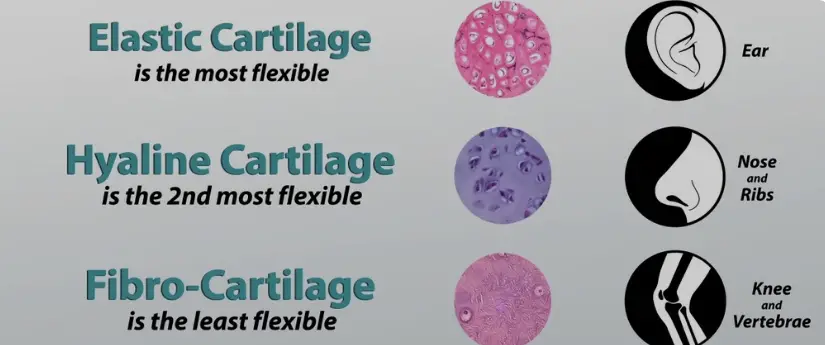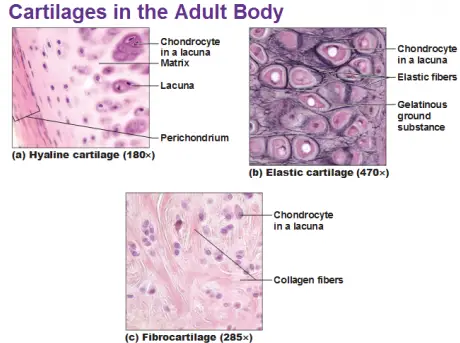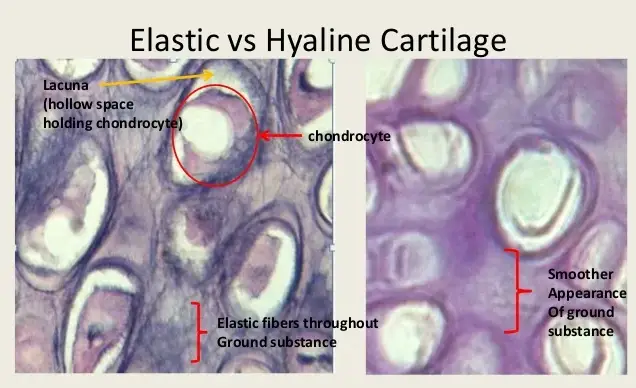Cartilage is a versatile and vital type of connective tissue found throughout the human body. It plays a critical role in forming the structure of various anatomical features, such as the nose, ears, and joints. Unlike other types of tissues, cartilage offers a unique combination of strength and flexibility, which is essential for its function in cushioning and support.
The primary difference between elastic cartilage and hyaline cartilage lies in their structure and function. Elastic cartilage, highly flexible and resilient, is found in areas requiring greater elasticity, such as the ears and epiglottis. On the other hand, hyaline cartilage, which is more rigid and abundant, serves as a precursor to bone in the fetus and covers bone surfaces in the joints to facilitate smooth movement.
Both types of cartilage are composed of cells called chondrocytes, but they differ significantly in their extracellular matrix, the non-cellular component that provides structural and biochemical support. The variations in this matrix contribute to their distinct properties, which are critical for their specific roles in the human body. Understanding these differences is not only fundamental to anatomy and physiology but also crucial for advancing medical treatments and surgeries that can enhance joint function and repair cartilaginous injuries.

Cartilage Basics
Definition and Function
Cartilage is a specialized, flexible connective tissue that plays a crucial role in the structure and function of various parts of the body. Unlike bone, cartilage is less rigid and can withstand more bending and stretching, making it essential in areas requiring flexibility and cushioning.
What is Cartilage?
Cartilage is made up of specialized cells known as chondrocytes which produce a large amount of extracellular matrix, consisting of collagen fibers, proteins, and sugars. This composition allows cartilage to function effectively as a shock absorber and a smooth surface for the movement of joints.
Roles in the Body
Cartilage serves several vital functions in the body:
- Supports soft tissues: It gives shape and support to other structures such as the ears, nose, and windpipe.
- Facilitates joint movements: Acts as a cushion between bones to prevent friction and facilitate easy movement at joints.
- Growth and development: In children, cartilage is a precursor to bone in the growth process.
Composition
Cellular Structure
The primary cell type found in cartilage is the chondrocyte, which resides in small spaces called lacunae within the gel-like matrix. These cells are responsible for maintaining the cartilage structure by continuously producing new matrix components and breaking down old ones.
Extracellular Matrix
The extracellular matrix of cartilage is what gives it its unique properties. It consists of:
- Collagen fibers: Provide strength and structure.
- Proteoglycans: Made up of proteins and sugars, these compounds attract water and give cartilage its compressive strength.
- Elastin fibers: Found in elastic cartilage, imparting flexibility and resilience.
Types of Cartilage
Primary Categories
There are three primary types of cartilage, each serving unique roles in the body:
- Hyaline Cartilage: The most common type, providing support and flexibility to joints.
- Fibrocartilage: Exceptionally tough, it is found in areas that undergo a lot of stress, like the spinal discs.
- Elastic Cartilage: Characterized by its flexibility, it is present in the ears and epiglottis.
Brief on Three Types
- Hyaline Cartilage: Appears glass-like and smooth, essential for joint motion.
- Fibrocartilage: The toughest type, key for withstanding heavy loads.
- Elastic Cartilage: Highly flexible, allowing structures like the ear to bend without damage.
Hyaline Cartilage
Characteristics
Appearance and Texture
Hyaline cartilage is semi-transparent and has a glassy, smooth appearance when viewed fresh. It is more flexible than bone but stiffer than muscle and other types of cartilage like elastic cartilage.
Locations in the Body
This type of cartilage is primarily found in:
- Articular surfaces of bones: Covers the ends of bones in major joints.
- Rib tips: Connects ribs to the sternum.
- Respiratory structures: Forms parts of the trachea and bronchi.
- Nasal cartilages: Contributes to the structure of the nose.
Functionality
Role and Importance
Hyaline cartilage is critical in the body for:
- Facilitating smooth joint movement: By covering the ends of bones in joints, it reduces friction and absorbs shock.
- Supporting respiratory structures: Maintains open airways in the respiratory system.
Composition Details
Cells and Matrix Specifics
The matrix of hyaline cartilage contains a high amount of type II collagen and is rich in proteoglycans. The chondrocytes are sparsely distributed throughout the matrix, which is crucial for the cartilage’s mechanical properties.

Elastic Cartilage
Characteristics
Appearance and Texture
Elastic cartilage is distinguished by its yellowish color and a high degree of flexibility, which differentiates it from the stiffer hyaline cartilage. Its matrix is densely packed with elastin fibers, which confer the ability to return to its original shape after bending or deformation.
Locations in the Body
This type of cartilage is primarily found in:
- Ears: Gives structure to the external ear.
- Epiglottis: Essential for covering the windpipe during swallowing to prevent food entry.
- Larynx: Supports the structures within the voice box.
Functionality
Role and Importance
Elastic cartilage plays a critical role in:
- Maintaining shape: Provides structure and shape to flexible body parts.
- Ensuring flexibility: Allows the parts of the body it supports to bend and return to their original shape without damage.
Composition Details
Cells and Matrix Specifics
While also composed of chondrocytes, the matrix of elastic cartilage is particularly rich in elastin fibers, aside from the usual proteoglycans and collagen. This unique composition allows for greater elasticity and durability in areas subjected to repeated bending.
Comparative Analysis
Physical Properties
Differences in Texture and Flexibility
The primary difference between elastic and hyaline cartilage in terms of physical properties is their texture and flexibility. Elastic cartilage is softer and more pliable due to its elastin fiber-rich matrix, allowing it to sustain repeated bending. In contrast, hyaline cartilage is firmer and provides a smooth surface for bone articulations in joints.
Biological Roles
Functional Differences in the Body
Elastic cartilage’s flexibility makes it ideal for structures that require frequent and safe deformation, such as the ears and epiglottis, while hyaline cartilage is best suited for load-bearing and reducing friction at articulating surfaces.
Cellular Composition
Contrast in Cellular Makeup
The cellular composition of elastic cartilage allows for greater flexibility and endurance under mechanical stress compared to hyaline cartilage. This is primarily due to the high content of elastin fibers interspersed among the chondrocytes in the matrix.
Response to Injury
Healing and Regeneration Capacities
Cartilage, in general, has limited healing capacity due to its avascular nature; however, elastic cartilage has a slightly better regenerative capacity than hyaline cartilage. This is because of the presence of more elastic fibers, which can help maintain structural integrity and promote recovery in some minor injuries.
Significance in Medical Science
Research Applications
Current Studies on Cartilage Types
Research into cartilage types, particularly elastic and hyaline, continues to be a focus in medical science due to their roles in human anatomy and potential in regenerative medicine. Studies often explore how these tissues can be artificially replicated or healed, offering insights into tissue engineering and therapeutic approaches.
Medical Treatments
Use in Surgeries and Therapies
Understanding the properties of elastic and hyaline cartilage aids significantly in various medical treatments:
- Joint repair and replacement: Particularly with hyaline cartilage in knee and hip surgeries.
- Reconstructive surgery: Elastic cartilage is often harvested for reconstructive surgeries, especially in rhinoplasty and otoplasty where flexibility and shape retention are crucial.
Frequently Asked Questions
What is cartilage?
Cartilage is a semi-rigid form of connective tissue that provides structure and support to various body parts without the rigidity of bone. It is essential for the proper functioning of joints and forms vital parts of the respiratory and auditory systems.
Where is hyaline cartilage found?
Hyaline cartilage is the most common type of cartilage and is found on the surfaces of bones in joints, the rib cage, nose, trachea, and larynx. Its primary function is to reduce friction and absorb shock in joint movements.
How does elastic cartilage differ from hyaline cartilage?
Elastic cartilage contains a higher concentration of elastin fibers within its matrix compared to hyaline cartilage, which primarily consists of collagen. This composition allows elastic cartilage to be more flexible and better withstand repeated bending.
Why is understanding different types of cartilage important?
Understanding the different types of cartilage aids in medical diagnostics and treatments, particularly in fields such as orthopedics and reconstructive surgery. It helps physicians tailor interventions that can restore function and alleviate pain in affected cartilaginous structures.
Conclusion
Cartilage plays a pivotal role in the human body, functioning as the foundational element for many structures that require both strength and flexibility. The distinctions between elastic and hyaline cartilage are significant, not only in their physical properties and biological roles but also in their implications for health and disease. Recognizing these differences enhances our ability to diagnose, treat, and innovate medical solutions for cartilaginous issues.
A deeper appreciation of cartilage types and their unique characteristics can lead to more effective treatments for degenerative diseases and injuries. As research continues to evolve, the potential to develop targeted therapies that improve the lives of patients with cartilage-related ailments remains promising, underlining the importance of foundational anatomical knowledge in medical practice.

